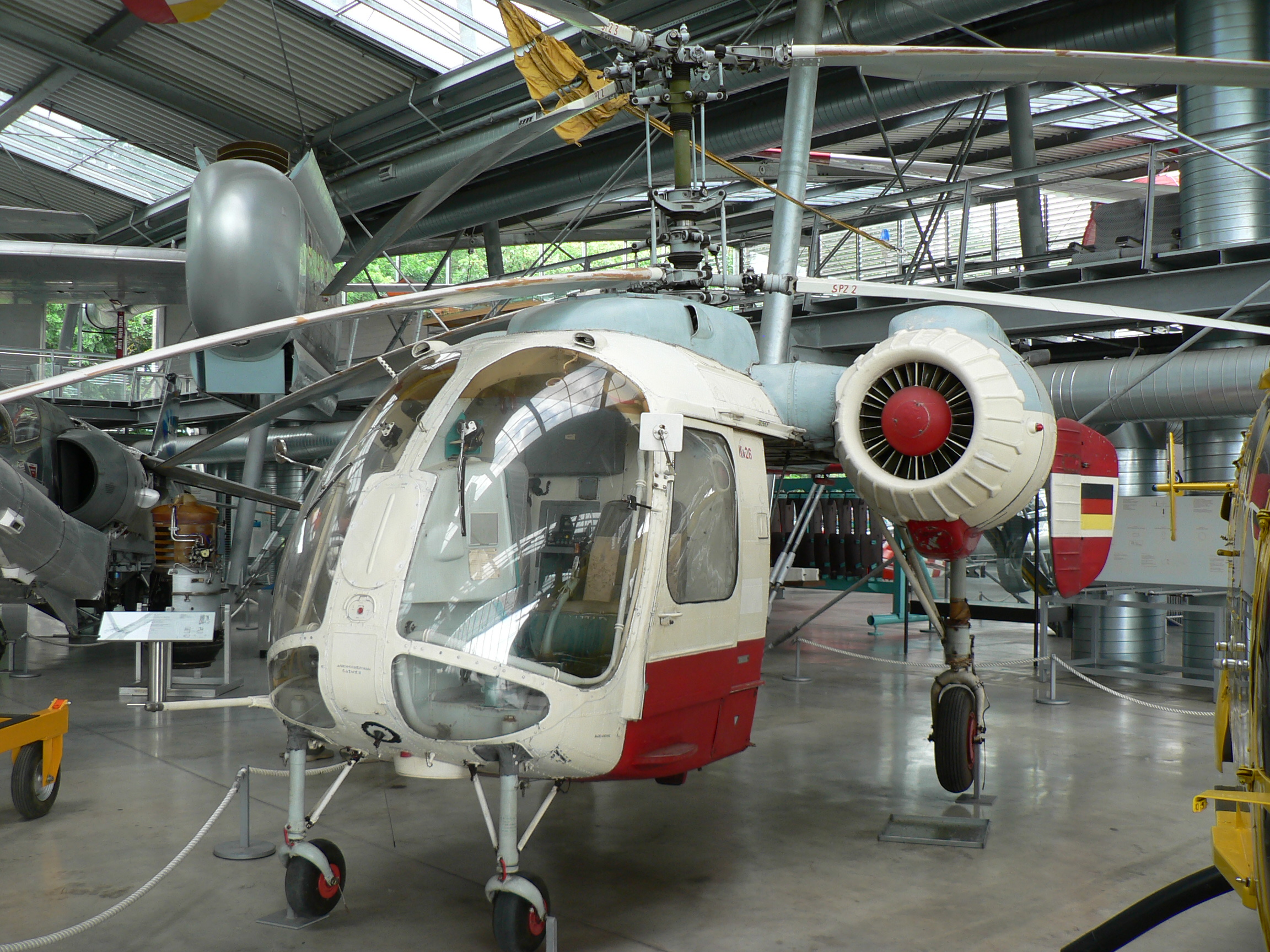- Kamov Ka-26
caption =
type = Light utility
manufacturer =Kamov
designer =
first flight =18 August 1965
introduced = 1966
retired =
status = Active
primary user =
more users =
produced = 1966-
number built = 850
unit cost =
developed from =
variants with their own articles =Kamov Ka-226 The
Kamov Ka-26 (NATO reporting name Hoodlum) is a Soviet light utility helicopter with co-axial rotors.Development
The Ka-26 entered production in
1966 . 850 have been built. A variant with a single engine was the Ka-126. A turboshaft-powered version is the Ka-226. (All the Ka-26/126/128/226 variants are codenamed "Hoodlum").Design
The fuselage of the Ka-26 consists of a fixed, bubble-shaped cockpit containing the pilot and co-pilot, plus a removable, variable box available in
medevac , passenger-carrying andcropduster versions. The helicopter can fly with or without the box attached, giving it much flexibility in use. The Ka-26 is small enough and handles well enough to land on a large truck bed.Fact|date=May 2008The main weakness of the Ka-26 is its
powerplant . It is powered by two 325 hp (242 kW) Vedeneev M-14V-26radial engine s mounted in off-boardgondola s. Thereciprocating engine s, although more responsive than modern turboshafts, are relatively maintenance intensive. The Ka-26 is underpowered with its two radial engines, especially when used in cropdusting role, where excess payload is common. No other helicopter exists in the world that runs at constant 95% engine power for most of its flight regime. This leaves the pilot with littlepower reserve for emergencies. Due to frequent overloads, the interconnect shaft which joins the two engines is prone to breakage and requires frequent inspection.The standard instrumentation of the Ka-26 resembles that of larger naval Kamovs and is considered excessive for civilian or cropdusting use. The large cockpit panel with its 18 main dials obscures a significant part of the right-downwards view direction from the cabin, which is crucial to avoid telephone and power lines in agricultural and other low-altitude roles. It is common practice to replace the instrument panel with a simplified layout, retaining only the six generally useful dials for better vision.
The low height of the lower rotor requires passengers and crew to approach from the rear when the rotors are turning, as it is low enough to contact a person's head at the front of the aircraft.
Operational history
The Ka-26 was used by some WARPAC armies in the light
desant or airborne role, but its slow (150 km/h) cruise speed vulnerability limits its military use. It is, however, eminently useful for cropdusting. The coaxial main rotor configuration, which makes the Ka-26 small and agile, also results in a delicate airflow pattern under the helicopter, providing a thorough yet mild distribution of chemicals onto the plants. The Ka-26 is often used to spray grape farms inHungary , where conventional "main rotor and tail rotor" layout helicopters would damage or up-root the vine-stocks with their powerful airflow.Fact|date=May 2008Variants
;Ka-26 Hoodlum-A :One or two crew utility light helicopter, powered by two 325-hp (243-kW) VMK (Vedeneyer) M-14V-26 radial piston engine. 850 built.;Ka-26SS :
NOTAR technology testbed for the Ka-118 fitted with tail jet beams.;Ka-126 Hoodlum-B :One or two crew utility light helicopter, powered by a 720-shp (537-kW) OMKB "Mars" (Glushenkov) TVD-100 turboshaft engines. First flown in 1986, and built under licence byIAR inRomania . Built in small numbers.;Ka-128:One prototype, powered by a 722-shp (538-kW) Turbomeca Arriel 1D1 turboshaft engine.;Kamov Ka-226 :Six or seven seat utility helicopter, powered by two 450-shp (335-kW) Rolls-Royce (Allison ) 250-C20R/2 turboshaft engines.Operators
Military operators
;BEN;flag|Bulgaria|1946;flag|Hungary;SRI;LTU : (police)
Civil operators
;USSR
*Aeroflot ;DDR
*Interflug pecifications (Ka-26)
aircraft specifications
plane or copter?=copter
jet or prop?=propref={name of first source}
crew=2
capacity=6 passengers
length main= 7.75 m
length alt= 25 ft 5 in
span main= 2x 13.00 m
span alt= 42 ft 8 in
height main= 4.05 m
height alt= 13 ft 3 in
area main= 265.5 m²
area alt= 2,856 ft²
airfoil=
empty weight main= 1,950 kg
empty weight alt= 4,300 lb
loaded weight main=
loaded weight alt=
useful load main= 900 kg
useful load alt= 1,980 lb
max takeoff weight main= 3,250 kg
max takeoff weight alt= 7,170 lb
more general=engine (prop)=
Ivchenko AI-14
type of prop=radial piston engines
number of props=2
power main=239 kW
power alt= 320 hp
power original=max speed main= 160 km/h
max speed alt= 100 mph
cruise speed main=
cruise speed alt=
never exceed speed main=
never exceed speed alt=
stall speed main=
stall speed alt=
range main= 465 km
range alt= 290 mi
ceiling main= 3,000 m
ceiling alt= 9,800 ft
climb rate main=
climb rate alt=
loading main= 12 kg/m²
loading alt= 2.5 lb/ft²
thrust/weight=
power/mass main= 150 W/kg
power/mass alt= 0.09 hp/lb
more performance=armament=
avionics=
ee also
aircontent
related=
*Kamov Ka-226 similar aircraft=
lists=
see also=
References
External links
* http://www.kamov.ru/
* http://www.aviation.ru/Ka/#26
Wikimedia Foundation. 2010.

